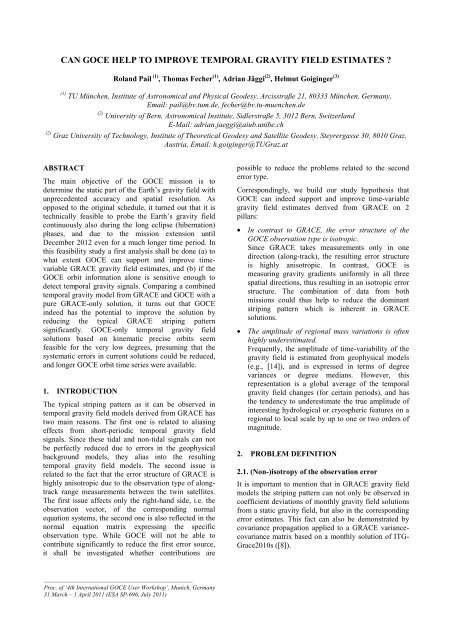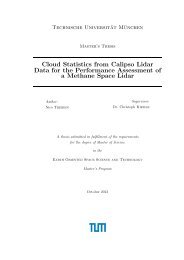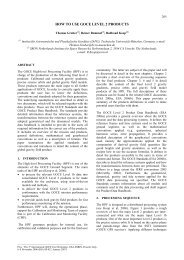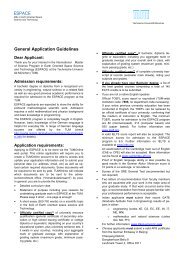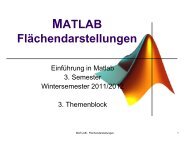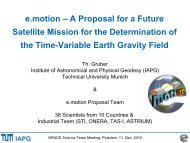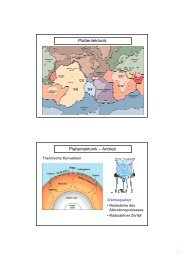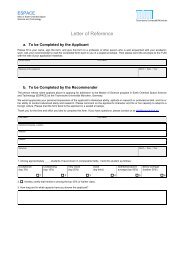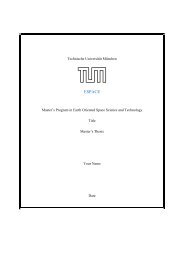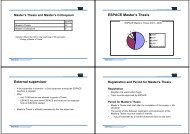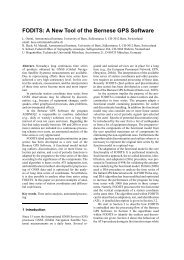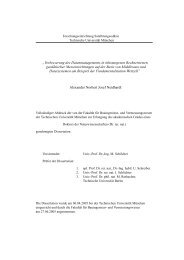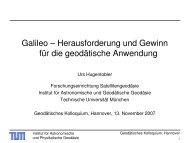can goce help to improve temporal gravity field estimates
can goce help to improve temporal gravity field estimates
can goce help to improve temporal gravity field estimates
Create successful ePaper yourself
Turn your PDF publications into a flip-book with our unique Google optimized e-Paper software.
CAN GOCE HELP TO IMPROVE TEMPORAL GRAVITY FIELD ESTIMATES ?<br />
Roland Pail (1) , Thomas Fecher (1) , Adrian Jäggi (2) , Helmut Goiginger (3)<br />
(1) TU München, Institute of Astronomical and Physical Geodesy, Arcisstraße 21, 80333 München, Germany,<br />
Email: pail@bv.tum.de, fecher@bv.tu-muenchen.de<br />
(2) University of Bern, Astronomical Institute, Sidlerstraße 5, 3012 Bern, Switzerland<br />
E-Mail: adrian.jaeggi@aiub.unibe.ch<br />
(2) Graz University of Technology, Institute of Theoretical Geodesy and Satellite Geodesy, Steyrergasse 30, 8010 Graz,<br />
Austria, Email: h.goiginger@TUGraz.at<br />
ABSTRACT<br />
The main objective of the GOCE mission is <strong>to</strong><br />
determine the static part of the Earth’s <strong>gravity</strong> <strong>field</strong> with<br />
unprecedented accuracy and spatial resolution. As<br />
opposed <strong>to</strong> the original schedule, it turned out that it is<br />
technically feasible <strong>to</strong> probe the Earth’s <strong>gravity</strong> <strong>field</strong><br />
continuously also during the long eclipse (hibernation)<br />
phases, and due <strong>to</strong> the mission extension until<br />
December 2012 even for a much longer time period. In<br />
this feasibility study a first analysis shall be done (a) <strong>to</strong><br />
what extent GOCE <strong>can</strong> support and <strong>improve</strong> timevariable<br />
GRACE <strong>gravity</strong> <strong>field</strong> <strong>estimates</strong>, and (b) if the<br />
GOCE orbit information alone is sensitive enough <strong>to</strong><br />
detect <strong>temporal</strong> <strong>gravity</strong> signals. Comparing a combined<br />
<strong>temporal</strong> <strong>gravity</strong> model from GRACE and GOCE with a<br />
pure GRACE-only solution, it turns out that GOCE<br />
indeed has the potential <strong>to</strong> <strong>improve</strong> the solution by<br />
reducing the typical GRACE striping pattern<br />
signifi<strong>can</strong>tly. GOCE-only <strong>temporal</strong> <strong>gravity</strong> <strong>field</strong><br />
solutions based on kinematic precise orbits seem<br />
feasible for the very low degrees, presuming that the<br />
systematic errors in current solutions could be reduced,<br />
and longer GOCE orbit time series were available.<br />
1. INTRODUCTION<br />
The typical striping pattern as it <strong>can</strong> be observed in<br />
<strong>temporal</strong> <strong>gravity</strong> <strong>field</strong> models derived from GRACE has<br />
two main reasons. The first one is related <strong>to</strong> aliasing<br />
effects from short-periodic <strong>temporal</strong> <strong>gravity</strong> <strong>field</strong><br />
signals. Since these tidal and non-tidal signals <strong>can</strong> not<br />
be perfectly reduced due <strong>to</strong> errors in the geophysical<br />
background models, they alias in<strong>to</strong> the resulting<br />
<strong>temporal</strong> <strong>gravity</strong> <strong>field</strong> models. The second issue is<br />
related <strong>to</strong> the fact that the error structure of GRACE is<br />
highly anisotropic due <strong>to</strong> the observation type of alongtrack<br />
range measurements between the twin satellites.<br />
The first issue affects only the right-hand side, i.e. the<br />
observation vec<strong>to</strong>r, of the corresponding normal<br />
equation systems, the second one is also reflected in the<br />
normal equation matrix expressing the specific<br />
observation type. While GOCE will not be able <strong>to</strong><br />
contribute signifi<strong>can</strong>tly <strong>to</strong> reduce the first error source,<br />
it shall be investigated whether contributions are<br />
_________________________________________________<br />
Proc. of ‘4th International GOCE User Workshop’, Munich, Germany<br />
31 March – 1 April 2011 (ESA SP-696, July 2011)<br />
possible <strong>to</strong> reduce the problems related <strong>to</strong> the second<br />
error type.<br />
Correspondingly, we build our study hypothesis that<br />
GOCE <strong>can</strong> indeed support and <strong>improve</strong> time-variable<br />
<strong>gravity</strong> <strong>field</strong> <strong>estimates</strong> derived from GRACE on 2<br />
pillars:<br />
• In contrast <strong>to</strong> GRACE, the error structure of the<br />
GOCE observation type is isotropic.<br />
Since GRACE takes measurements only in one<br />
direction (along-track), the resulting error structure<br />
is highly anisotropic. In contrast, GOCE is<br />
measuring <strong>gravity</strong> gradients uniformly in all three<br />
spatial directions, thus resulting in an isotropic error<br />
structure. The combination of data from both<br />
missions could thus <strong>help</strong> <strong>to</strong> reduce the dominant<br />
striping pattern which is inherent in GRACE<br />
solutions.<br />
• The amplitude of regional mass variations is often<br />
highly underestimated.<br />
Frequently, the amplitude of time-variability of the<br />
<strong>gravity</strong> <strong>field</strong> is estimated from geophysical models<br />
(e.g., [14]), and is expressed in terms of degree<br />
variances or degree medians. However, this<br />
representation is a global average of the <strong>temporal</strong><br />
<strong>gravity</strong> <strong>field</strong> changes (for certain periods), and has<br />
the tendency <strong>to</strong> underestimate the true amplitude of<br />
interesting hydrological or cryospheric features on a<br />
regional <strong>to</strong> local scale by up <strong>to</strong> one or two orders of<br />
magnitude.<br />
2. PROBLEM DEFINITION<br />
2.1. (Non-)isotropy of the observation error<br />
It is important <strong>to</strong> mention that in GRACE <strong>gravity</strong> <strong>field</strong><br />
models the striping pattern <strong>can</strong> not only be observed in<br />
coefficient deviations of monthly <strong>gravity</strong> <strong>field</strong> solutions<br />
from a static <strong>gravity</strong> <strong>field</strong>, but also in the corresponding<br />
error <strong>estimates</strong>. This fact <strong>can</strong> also be demonstrated by<br />
covariance propagation applied <strong>to</strong> a GRACE variancecovariance<br />
matrix based on a monthly solution of ITG-<br />
Grace2010s ([8]).
Rigorous covariance propagation was applied <strong>to</strong> the full<br />
GRACE variance-covariance matrix <strong>to</strong> derive geoid<br />
height errors for different maximum degrees. This study<br />
was performed for the monthly solution of August 2009.<br />
(It was checked that the near 7 days GRACE sub-cycle<br />
in this period does not have an impact by repeating this<br />
procedure for data from August 2008, yielding very<br />
similar results.) The evaluation was performed<br />
regionally for an area covering whole South America.<br />
Figure 1 shows the results for maximum degrees of 30,<br />
40, 60 and 120 of the series expansion. Obviously, also<br />
in the error <strong>estimates</strong> this striping pattern is visible,<br />
starting already at degrees 30 <strong>to</strong> 40.<br />
This is a key conclusion for our study idea, because the<br />
error <strong>estimates</strong> reflect only the orbit configuration and<br />
measurement type (in our case along-track ranging), but<br />
not the right-hand side of our normal equation system.<br />
In contrast, aliasing problems affect only the<br />
observations (and thus the right-hand side). Thus, we<br />
<strong>can</strong> conclude that a signifi<strong>can</strong>t part of the striping<br />
pattern is related <strong>to</strong> the GRACE observation type.<br />
(a) mm (b)<br />
mm<br />
(c) mm (d)<br />
mm<br />
Figure 1. Geoid height standard deviations [mm]<br />
derived by rigorous error propagation based on the full<br />
variance-covariance information of the monthly ITG-<br />
Grace2010s model for August 2009: expansion up <strong>to</strong><br />
maximum degree (a) 30; (b) 40; (c) 60; (d) 120.<br />
2.2. Amplitude of <strong>temporal</strong> <strong>gravity</strong> <strong>field</strong> variations<br />
Frequently the time variability of <strong>gravity</strong> <strong>field</strong> signals of<br />
a certain geophysical source is estimated from<br />
geophysical models by means of a global analysis. The<br />
corresponding spectral representation of the rms<br />
variability is given in degree variances. This global<br />
representation of time variability, however,<br />
under<strong>estimates</strong> the true amplitude of regional features<br />
dramatically.<br />
Figure 2 shows the rms variability of the global <strong>gravity</strong><br />
<strong>field</strong> related <strong>to</strong> land hydrology and ice mass variations.<br />
It was derived from geophysical models for a period of<br />
11 years between 1995 and 2005. Concerning<br />
hydrology, the large-scale model PCR-GLOBWB<br />
(PCRaster GLOBal Water Balance), which is driven by<br />
ECMWF ([1]) and ERA-40 ([12]), has been used, while<br />
for the ice sheets the time series is composed of mass<br />
fluxes derived from ERA-40 up <strong>to</strong> 2001, and ECMWF<br />
Operational Analysis beyond. These data sets have been<br />
created in the course of the ESA project “Moni<strong>to</strong>ring<br />
and Modelling Individual Sources of Mass Distribution<br />
and Transport in the Earth System by Means of<br />
Satellites” ([13]).<br />
mm EWH<br />
Figure 2. Global distribution of rms variability [mm<br />
EWH] of <strong>temporal</strong> hydrology and cryospheric signals.<br />
In order <strong>to</strong> evaluate the local variability (and thus the<br />
detectable signal) in the frame of a global analysis based<br />
on degree variances, the following procedure has been<br />
executed. First, a certain hydrological basis was<br />
selected, and the signals outside this region were set <strong>to</strong><br />
zero. Then a harmonic analysis was performed, and the<br />
corresponding degree variances based on the rms<br />
variability have been derived. In the final step, these<br />
(global) degree variances were normalized by the area<br />
of the hydrological basin relative <strong>to</strong> the <strong>to</strong>tal global<br />
definition domain. Thus a more realistic magnitude for<br />
the regional variation signal is obtained. Figure 3 shows<br />
the resulting degree variance <strong>estimates</strong>.<br />
Evidently, the <strong>temporal</strong> variation signals of these three<br />
regions of interest are above the current GRACE error<br />
curve up <strong>to</strong> degree and order 50 <strong>to</strong> 60. However, it has<br />
been demonstrated by the numerical studies described
efore that the GRACE solutions are affected by stripes<br />
already at degree 40. Since we expect that they <strong>can</strong> be<br />
reduced signifi<strong>can</strong>tly by the inclusion of GOCE, a<br />
cleaner signal representation and a reduction of striping<br />
artefacts might be achievable.<br />
Figure 3. Degree rms of <strong>temporal</strong> variation signals in<br />
selected regions.<br />
3. CASE STUDY 1: IMPROVEMENT OF<br />
GRACE GRAVITY FIELD ESTIMATES<br />
In this case study it shall be investigated if GRACE<br />
<strong>temporal</strong> <strong>gravity</strong> <strong>field</strong> <strong>estimates</strong> <strong>can</strong> be <strong>improve</strong>d by the<br />
inclusion of GOCE data. The study logic is <strong>to</strong> compute<br />
first a GRACE-only <strong>gravity</strong> <strong>field</strong> solution, which shall<br />
then be combined with GOCE in order <strong>to</strong> analyze the<br />
impact.<br />
For this study we chose <strong>to</strong> compute bi-monthly <strong>gravity</strong><br />
<strong>field</strong> solutions, but this case study <strong>can</strong> be reduced <strong>to</strong><br />
monthly solutions without major changes in the results<br />
or conclusions, because the global coverage of GOCE is<br />
already sufficient after one month.<br />
Of course, one pre-requisite of this study is that full<br />
GRACE and GOCE normal equations are available for<br />
the same time period. Since no ITG-Grace2010s <strong>gravity</strong><br />
<strong>field</strong> solutions (the only model that provides also<br />
variance-covariance information, from which the<br />
normal equations <strong>can</strong> be reconstructed) are available<br />
after August 2009, there is no overlapping period with<br />
the GOCE operational phase starting in Oc<strong>to</strong>ber 2009.<br />
Therefore, GRACE monthly solutions for November<br />
and December 2009 have been generated up <strong>to</strong><br />
degree/order 120 using the celestial mechanics approach<br />
([2], [3], [7]). It should be emphasized that during this<br />
period GRACE flew a 7-days sub-cycle, which might<br />
slightly decrease the quality of the GRACE solution.<br />
We will come back <strong>to</strong> this issue later on.<br />
Concerning GOCE, full normal equations up <strong>to</strong><br />
degree/order 224 from satellite <strong>gravity</strong> gradiometry<br />
(SGG) have been generated applying the time-wise<br />
method ([9], [10]) for this bi-monthly period, while the<br />
GPS satellite-<strong>to</strong>-satellite (SST) component based on<br />
kinematic precise orbits was evaluated by the celestial<br />
mechanics approach up <strong>to</strong> degree/order 120 ([6]). These<br />
two normal equations have been optimally combined <strong>to</strong><br />
result in a consistent full GOCE normal equation system<br />
up <strong>to</strong> degree/order 224.<br />
As a next step, the two monthly GRACE normal<br />
equations complete <strong>to</strong> degree/order 120 have been<br />
jointly inverted <strong>to</strong> obtain a GRACE-only solution.<br />
Finally, this solution has been combined, again by<br />
addition of normal equations, with the GOCE normal<br />
equations <strong>to</strong> obtain a bi-monthly combined global<br />
<strong>gravity</strong> <strong>field</strong> estimate.<br />
The dashed curves in Figure 4 show the formal errors in<br />
terms of degree medians of the individual GRACE and<br />
GOCE solutions, as well as the combined model. The<br />
cross-over of the GOCE and GRACE performance<br />
curves occurs at degree 85. The GRACE-only <strong>estimates</strong><br />
(red dashed) could only slightly be <strong>improve</strong>d by GOCE<br />
(green dashed), resulting in the blue dashed curve of the<br />
combined model. Additionally, the coefficient<br />
differences <strong>to</strong> the independent static GRACE model<br />
ITG-Grace2010s are displayed as solid curves of the<br />
corresponding color. Concerning GOCE, the most<br />
obvious deviation from the formal errors occurs in the<br />
low degrees, which is mainly due <strong>to</strong> non-parameterized<br />
systematic errors in the GOCE SST solution. Also the<br />
GRACE as well as the combined solution deviate<br />
signifi<strong>can</strong>tly from the formal errors, but the main reason<br />
here is that beside observation errors also time-variable<br />
<strong>gravity</strong> <strong>field</strong> signal is inherent. As a reference, also the<br />
degree medians of the <strong>temporal</strong> variation signals, as<br />
shown in Fig. 3, are displayed.<br />
Figure 4. Degree medians of GRACE-only, GOCE-only<br />
and combined <strong>gravity</strong> <strong>field</strong> models; formal errors<br />
(dashed curves) and differences <strong>to</strong> static reference<br />
model ITG-Grace2010s (solid curves).
An even more stunning result <strong>can</strong> be observed when<br />
analyzing the global <strong>field</strong> of the estimated <strong>temporal</strong><br />
<strong>gravity</strong> <strong>field</strong> signals. Figure 5 shows deviations of the<br />
bi-monthly solutions from the static ITG-Grace2010s<br />
reference <strong>field</strong> in terms of equivalent water height for<br />
(a) the GRACE-only and (b) the combined<br />
GRACE+GOCE solution up <strong>to</strong> degree/order 30.<br />
Evidently, the striping structure of the GRACE-only<br />
solution <strong>can</strong> be signifi<strong>can</strong>tly reduced when including<br />
GOCE normal equations.<br />
(a)<br />
(b)<br />
Figure 5. Temporal <strong>gravity</strong> <strong>field</strong> signals in terms of<br />
equivalent water heights [m] evaluated up <strong>to</strong><br />
degree/order 30: a) GRACE-only; b) GRACE+GOCE<br />
combination.<br />
This effect appears even more clearly when analyzing<br />
the difference <strong>field</strong>s at degree/order 40. The results are<br />
shown in Fig. 6. It should be emphasized that this<br />
signifi<strong>can</strong>t <strong>improve</strong>ment is not related <strong>to</strong> the fact that<br />
GOCE <strong>can</strong> introduce much additional <strong>temporal</strong> <strong>gravity</strong><br />
<strong>field</strong> information, but it is rather an indirect effect, by<br />
stabilizing the GRACE normal equations. Here, the<br />
isotropic error structure of the GOCE normal equations<br />
supports the reduction of the striping pattern. In this<br />
sense, it <strong>can</strong> be interpreted as an additional constraint.<br />
Compared <strong>to</strong> any other “regularization” approach, the<br />
true additional value lies in the fact that a completely<br />
independent normal equation system based on a<br />
complementary <strong>gravity</strong> mission for exactly the same<br />
time period is used. In this sense, the inclusion of<br />
(bi-)monthly GOCE normal equations is more<br />
consistent. Again it should be emphasized that a similar<br />
result is expected when reducing the scenario <strong>to</strong><br />
monthly solutions, because the performance of both<br />
GRACE and GOCE scale down in an analogous way,<br />
and the monthly ground track coverage of GOCE is<br />
highly sufficient.<br />
m EWH (a)<br />
m EWH<br />
m EWH (b)<br />
m EWH<br />
Figure 6. Temporal <strong>gravity</strong> <strong>field</strong> signals in terms of<br />
equivalent water heights [m] evaluated up <strong>to</strong><br />
degree/order 40: a) GRACE-only; b) GRACE+GOCE<br />
combination.<br />
The impact for a “good” GRACE month, i.e., a month<br />
without the 7-days sub-cycle, has been investigated by a<br />
numerical study. It turns out that the impact of GOCE is<br />
slightly less severe, but still signifi<strong>can</strong>t.<br />
4. CASE STUDY 2: TEMPORAL GRAVITY<br />
FROM GOCE-ONLY<br />
In a second case study, it shall be evaluated whether<br />
GOCE <strong>can</strong> observe <strong>temporal</strong> <strong>gravity</strong> <strong>field</strong> signals by its<br />
own. Due <strong>to</strong> the fact that the GOCE gradiometer works<br />
with highest performance only in the bandwidth of 5 <strong>to</strong>
100 mHz, the long-wavelength <strong>gravity</strong> <strong>field</strong><br />
information, where <strong>temporal</strong> <strong>gravity</strong> <strong>field</strong> signals show<br />
up most prominently, is derived mainly from the GPS<br />
orbit information.<br />
Therefore, we concentrate here on the GOCE SST<br />
component. Monthly <strong>gravity</strong> <strong>field</strong>s complete <strong>to</strong><br />
degree/order 120 have been estimated based on the<br />
kinematic precise science orbits for the time period from<br />
November 2009 <strong>to</strong> June 2010 applying the celestial<br />
mechanics approach ([2], [3]). If at all, <strong>temporal</strong> <strong>gravity</strong><br />
<strong>field</strong> effects will be detectable only in the very low<br />
degrees. Therefore, difference <strong>field</strong>s <strong>to</strong> the static <strong>gravity</strong><br />
<strong>field</strong> model ITG-Grace2010s have been computed up <strong>to</strong><br />
degree/order 10. As reference solutions, the <strong>temporal</strong><br />
<strong>gravity</strong> <strong>field</strong> models of GFZ RL04 ([5]) up <strong>to</strong> the same<br />
degree/order have been analyzed. Reductions of<br />
atmosphere and oceans (products GAC and GAD) have<br />
been added back.<br />
m EWH<br />
Figure 7. Temporal <strong>gravity</strong> <strong>field</strong> signals in terms of<br />
equivalent water heights [m] evaluated up <strong>to</strong><br />
degree/order 10 of the GFZ RL04 model for June 2010.<br />
m EWH<br />
Figure 8. Temporal <strong>gravity</strong> <strong>field</strong> signals in terms of<br />
equivalent water heights [m] evaluated up <strong>to</strong><br />
degree/order 10 derived from GOCE SST for June<br />
2010.<br />
Exemplarily, Fig. 7 shows the <strong>temporal</strong> <strong>gravity</strong> <strong>field</strong><br />
signal in terms of equivalent water heights up <strong>to</strong><br />
degree/order 10 of the GFZ model for June 2010. The<br />
corresponding <strong>field</strong> derived from the same month of<br />
GOCE kinematic orbit data is shown in Fig. 8.<br />
Evidently, although these <strong>field</strong>s are on the same order of<br />
magnitude, the noise level of the GOCE SST solution<br />
dominates the picture. Correlations between Fig. 7 and<br />
Fig. 8 seem <strong>to</strong> appear in certain regions with large<br />
<strong>temporal</strong> variation signals, such as Greenland, South<br />
America and the Western ice shield in Antarctica, but<br />
similar amplitudes also appear in regions where no<br />
strong <strong>temporal</strong> <strong>gravity</strong> <strong>field</strong> signal is <strong>to</strong> be expected.<br />
One of the main future challenges is <strong>to</strong> reduce<br />
systematic effects in the GOCE SST solutions. As it <strong>can</strong><br />
be clearly seen in Fig. 4, the actual errors in the low<br />
degrees are considerably larger than the formal errors,<br />
demonstrating that systematic effects contribute<br />
signifi<strong>can</strong>tly <strong>to</strong> the <strong>to</strong>tal error budget. If we succeeded <strong>to</strong><br />
reduce these systematic errors by a fac<strong>to</strong>r of 5-10, and<br />
thus being consistent with the formal errors, it could be<br />
expected that <strong>temporal</strong> <strong>gravity</strong> <strong>field</strong> effects <strong>can</strong> be<br />
recovered at least for the very low degrees.<br />
Additionally, longer time series of GOCE orbit data will<br />
be needed <strong>to</strong> estimate them either by co-estimating trend<br />
and periodic signals, or by stacking monthly <strong>gravity</strong><br />
<strong>field</strong> <strong>estimates</strong> <strong>to</strong> reduce the noise patterns, as it has<br />
been successfully done for CHAMP ([11]).<br />
Although GOCE orbits the Earth in a much lower<br />
altitude than CHAMP, the added value will not be<br />
excessively high, because the signal attenuation with<br />
altitude is not very strong for the very low degrees, and<br />
thus the lower GOCE orbit altitude does not contribute a<br />
lot <strong>to</strong> the higher sensitivity. However, the orbit accuracy<br />
of GOCE, which is estimated <strong>to</strong> be in the order of<br />
2- 2.5 cm 3D rms ([4]), is considered <strong>to</strong> be a favourable<br />
argument for GOCE, once the full potential of this high<br />
accuracy <strong>can</strong> be exploited and systematic errors <strong>can</strong> be<br />
signifi<strong>can</strong>tly reduced.<br />
5. CONCLUSIONS<br />
Two case studies based on real GRACE and GOCE data<br />
have been performed. In the first one, it was<br />
investigated whether GOCE <strong>can</strong> support and <strong>improve</strong><br />
GRACE <strong>temporal</strong> <strong>gravity</strong> <strong>field</strong> <strong>estimates</strong>. In fact, the<br />
inclusion of full GOCE normal equations for the<br />
processing of combined GRACE+GOCE <strong>temporal</strong><br />
<strong>gravity</strong> <strong>field</strong> models indeed <strong>can</strong> <strong>improve</strong> the solutions,<br />
in terms of signifi<strong>can</strong>t reduction of the typical striping<br />
pattern of GRACE-only solutions. Here, the favourable<br />
isotropic error behaviour of GOCE <strong>can</strong> <strong>help</strong> <strong>to</strong> stabilize<br />
the combined normal equation systems. In this sense,
GOCE normal equations are constraining the solutions.<br />
Compared <strong>to</strong> any other “regularization” method, we<br />
consider normal equations derived from a<br />
complementary mission for exactly the same period as<br />
the ideal <strong>can</strong>didate for such a constraint.<br />
In a second study, we investigated if GOCE <strong>can</strong> detect<br />
<strong>temporal</strong> <strong>gravity</strong> <strong>field</strong> signal on its own. Due <strong>to</strong> the<br />
weak sensitivity of gradiometry <strong>to</strong> the low harmonic<br />
degrees, if at all, <strong>temporal</strong> <strong>gravity</strong> <strong>field</strong> signals <strong>can</strong> be<br />
derived solely from the precise GOCE orbits. A very<br />
first analysis has revealed that the currently achievable<br />
accuracies of <strong>temporal</strong> <strong>gravity</strong> <strong>field</strong> solutions, evaluated<br />
for the low degrees, is in the same amplitude range as<br />
the time-variable <strong>gravity</strong> <strong>field</strong> signals, but still exceed<br />
them. However, current GOCE SST <strong>gravity</strong> <strong>field</strong><br />
solutions are dominated by systematic errors in the low<br />
degrees. A reduction of these systematic errors by<br />
<strong>improve</strong>d processing techniques (both concerning the<br />
orbit and the <strong>gravity</strong> <strong>field</strong> processing), <strong>to</strong>gether with<br />
longer GOCE orbit time series <strong>to</strong> be analyzed, should<br />
result in the feasibility <strong>to</strong> recover <strong>temporal</strong> <strong>gravity</strong> <strong>field</strong><br />
signals at least for the very low degrees.<br />
6. REFERENCES<br />
1. Andersson, E., Bauer, P., Beljaars, A., Chevallier, F.,<br />
Holm, E., Janiskova, M., Kallberg, P., Kelly, G., Lopez,<br />
P., McNally, A., Moreau, E., Simmons, A.J., Thepaut, J.-<br />
N., Tompkins, A.M. (2005). Assimilation and modelling<br />
of the atmospheric hydrological cycle in the ECMWF<br />
forecasting system, Bull. Amer. Meteor. Soc., 86, 3, 387-<br />
401.<br />
2. Beutler, G., Jäggi, A., Mervart, L., Meyer, U. (2010). The<br />
celestial mechanics approach: theoretical foundations.<br />
Journal of Geodesy, 84:10, 605-624, doi: 10.1007/s00190-<br />
010-0401-7.<br />
3. Beutler, G., Jäggi, A., Mervart, L., Meyer, U. (2010): The<br />
celestial mechanics approach: application <strong>to</strong> data of the<br />
GRACE mission. Journal of Geodesy, 84:11, 661-681,<br />
doi: 10.1007/s00190-010-0402-6.<br />
4. Bock, H., Jäggi, A., Meyer, U., Visser, P., van den IJssel.<br />
J., van Helleputte, T., Heinze, M., Hugen<strong>to</strong>bler, U. (2011).<br />
GPS-derived orbits for the GOCE satellite. Journal of<br />
Geodesy, accepted for publication.<br />
5. Flechtner, F., Dahle, C., Neumayer, K.H., König, R.,<br />
Förste, C. (2010). The Release 04 CHAMP and GRACE<br />
EIGEN Gravity Field Models. In: F. Flechtner et al. (eds.):<br />
System Earth via Geodetic-Geophysical Space<br />
Techniques, Springer, ISBN 978-3-642-10227-1, doi: 978-<br />
3-642-10228-8, 41 – 58.<br />
6. Jäggi, A., Prange, L., Hugen<strong>to</strong>bler, U. (2011). Impact of<br />
covariance information of kinematic positions on orbit<br />
reconstruction and <strong>gravity</strong> <strong>field</strong> recovery, Advances in<br />
Space Research, DOI: 10.1016/j.asr.2010.12.009, in press.<br />
7. Jäggi, A., Beutler, G., Mervart, L. (2010). GRACE<br />
Gravity Field Determination using the Celestial Mechanics<br />
Approach – First Results, in Gravity, Geoid and Earth<br />
Observation, edited by S. Mertikas, pp. 177-184, Springer.<br />
8. Mayer-Gürr, T., Kurtenbach, E. & Eicker, A. (2010). ITG-<br />
Grace2010 Gravity Field Model; www.igg.unibonn.de/apmg/index.php?id=itg-grace2010.<br />
9. Pail, R., Goiginger, H., Mayrhofer, R., Schuh, W.-D.,<br />
Brockmann, J.M., Krasbutter, I., Höck, E., Fecher, T.<br />
(2010). GOCE <strong>gravity</strong> <strong>field</strong> model derived from orbit and<br />
gradiometry data applying the time-wise method. In:<br />
Lacoste-Francis, H. (eds.) Proceedings of the ESA Living<br />
Planet Symposium, ESA Publication SP-686,<br />
ESA/ESTEC, ISBN (Online) 978-92-9221-250-6, ISSN<br />
1609-042X.<br />
10. Pail, R., Bruinsma, S., Migliaccio, F., Förste, C.,<br />
Goiginger, H., Schuh, W.-D, Hoeck, E., Reguzzoni, M.,<br />
Brockmann, J.M, Abrikosov, O., Veicherts, M., Fecher,<br />
T., Mayrhofer, R., Krasbutter, I., Sanso, F., Tscherning,<br />
C.C. (2011). First GOCE <strong>gravity</strong> <strong>field</strong> models derived by<br />
three different approaches. Jounal of Geodesy, accepted<br />
for publication, doi: 10.1007/s00190-011-0467-x.<br />
11. Prange, L., Meyer, U., Jäggi, A., Beutler, G. (2011).<br />
Temporal <strong>gravity</strong> <strong>field</strong> solutions at the AIUB. Geophysical<br />
Research Abstracts, Vol. 13, EGU2011-6641, EGU<br />
General Assembly 2011.<br />
12. Troccoli, A., Kållberg, P. (2004). Precipitation correction<br />
in the ERA-40 reanalysis, ERA-40, Project Report Series,<br />
13.<br />
13. Van Dam, T, Visser, P., Sneeuw, N., Losch, M., Gruber,<br />
T., Bamber, J., Bierkens, M., King, M., Smit, M. (2008).<br />
Moni<strong>to</strong>ring and Modelling Individual Sources of Mass<br />
Distribution and Transport in the Earth System by Means<br />
of Satellites. Final Report, ESA contract no. 20403,<br />
European Space Agency, Noordwijk.<br />
14. Wahr, J., Molenaar, M., Bryan, F. (1998). Time variability<br />
of the Earth's <strong>gravity</strong> <strong>field</strong>: Hydrological and oceanic<br />
effects and their possible detection using GRACE, J.<br />
Geophys. Res., 103(B12), 30,205–30,229.


